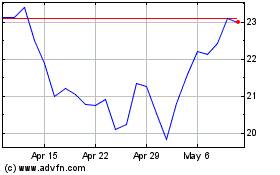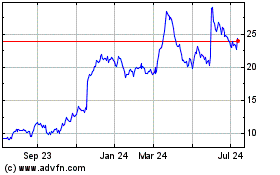By Eric Morath and Suzanne Kapner
Consumers boosted spending in April to the highest levels in
more than a year, accelerating their turn toward online shopping
and widening the divide between in-store retailers and Internet
outlets pitching lower prices and convenience.
While data from the Commerce Department on Friday showed overall
retail sales rose 1.3% in April from a month earlier, the category
that includes shopping on Amazon.com Inc. and rival websites and
apps grew 2.4%. And in the past year, Internet and catalog sales
have grown more than three times as fast as overall sales, up
10.2%. Department-store sales, meanwhile, sank 1.7% over the past
12 months.
Results from the retail sector this past week showed how the
shift is knocking down major companies despite resilience in the
broader economy. Major retailers including Macy's Inc., Kohl's
Corp. and Nordstrom Inc. this week reported sharply lower sales and
profits, while Gap Inc. said it was considering closing more stores
after sales continued to sink.
Amazon is now the second-largest apparel seller in the U.S.,
behind Wal-Mart Stores Inc., according to Morgan Stanley. That
category was once dominated by department stores.
"Just like bookstores and music stores and hardware stores
before them, apparel retailers are underestimating how fast Amazon
is going to eat their lunch," said Joel Bines, co-head of
consulting firm AlixPartners LLP's retail practice. "We've seen
this movie before."
Executives at traditional large retailers struggled to explain
the slump, which for some companies was their worst since the
recession. Some pointed to a decrease in mall traffic, while others
said shoppers were spending more on items their stores don't sell
such as entertainment, travel and food.
"The consumer was simply spending their hard-earned dollars in
experiences, entertainment and to beautify their home," J.C. Penney
Co. Chief Executive Marvin Ellison said Friday after reporting
lower-than-expected sales. The chain is responding by adding
appliances and other home goods to its stores.
For economists, Friday's data offered a glimmer of optimism, no
matter where the money was being spent. Consumers remain the
primary driver of the U.S. economy, accounting for more than
two-thirds of economic output. A spending slowdown in the first
three months of the year was partly responsible for economic growth
nearly stalling, climbing at just a 0.5% seasonally adjusted annual
rate.
Economists say April's spending surge points to faster growth,
as measured by gross domestic product, this spring. Forecasting
firm Macroeconomic Advisers raised its expectation for
second-quarter GDP growth to a 2.3% annualized advance from 2%.
Barclays raised its forecast to 2.2% from 2%.
The Federal Reserve Bank of Atlanta's real-time estimate of
economic growth moved Friday to a 2.8% gain, from the prior
estimate of 2.2%.
If consumers can spur stronger economic growth in the coming
months, that could influence the Federal Reserve's decision on when
to raise its benchmark interest rate. After the Fed in December
raised rates from near-zero, a choppy economic performance so far
this year has led the central bank to delay a second increase.
Policy makers next meet in mid-June.
"With diminished headwinds from abroad and consumers responding
to growing household income and wealth, consumer spending should
improve over the course of the second quarter," Boston Fed
President Eric Rosengren said Thursday.
Large department stores were once bellwethers of consumer
behavior, but there has been a clear and growing divergence in
recent years.
Improved online sales is driving revenue growth at Blair Candy
Co., said owner Pamela Macharola. The business has shifted from
only supplying the region around its Altoona, Pa., warehouse to
reaching a national customer base nostalgic for classic treats such
as Lemonheads and Atomic Fireballs.
"We're doing very well and we attribute a lot of that to gas
prices going down," she said. "When people feel good, and have more
money at the end of the week, they're willing to spend."
But larger retailers seem to be struggling to make a similar
pivot, even though they are getting an increasing amount of revenue
from their own e-commerce operations.
Executives at Nordstrom, which gets 20% of its sales online,
cited weak traffic to malls as well as aggressive discounting
online for its slump. "There is a lot of excess product out in the
marketplace. It's certainly easy to shop online. There is some
heavy, heavy discounting going on, and we're seeing that effect in
our business," said co-president Erik Nordstrom.
The global economy is ratcheting up price pressures as well.
Consumer prices for apparel, homewares and other goods often
imported from overseas have flattened or fallen due to a stronger
dollar. In some cases that means retailers' margins shrink between
placing orders and stocking their shelves, IHS economist Chris G.
Christopher said.
Even higher-priced luxury retailers haven't been immune.
Hudson's Bay Co. on Friday warned of weaker-than-expected sales for
its recent quarter, dragged down by its Saks Fifth Avenue
chain.
Foot traffic to apparel stores declined 7.2% in April, according
to John Kernan, an analyst with Cowen & Co. And Nordstrom
finance chief Michael Koppel said Thursday that "we continue to see
traffic falling off in malls."
When shoppers do visit malls, they are increasingly spending
money on entertainment such as movies and bowling and services such
as hair salons and fitness centers, according to Liz Holland, chief
executive of Abbell Associates, a real-estate redevelopment firm.
Despite Amazon's rise, not all traditional retailers are
struggling. Fast-fashion chains such as H&M Hennes &
Mauritz AB have been posting strong sales recently, as have
specialty retailers like Foot Locker Inc.
Amazon, meanwhile, continues to expand into new categories such
as grocery and fashion. The web retailer's sales jumped 28% in the
latest quarter, its fastest growth since 2012, and the company
booked its fourth straight profitable quarter with expanded margins
in its core retail business.
Analysts are expecting strong results this coming week from Home
Depot Inc. and Lowe's Cos., which are benefiting from strength in
the housing market. And off-price retailer TJX Cos. is expected to
post sales increases as well.
But earnings from Wal-Mart and Target Corp. are likely to come
under pressure from higher wages and ecommerce investments.
With the unemployment rate at a historically low level -- 5% in
April -- and wages showing signs of increasing even beyond the
retail sector, consumers are positioned to spend. But they remain
cautious nearly seven years after the recession ended. Two-thirds
of their outlays go to services, from rent to doctor visits to
Netflix subscriptions.
"The consumer sector is the strongest sector in this economy,"
IHS's Mr. Christopher said. "Discount stores are doing well and
online stores are doing well, but these department stores are
getting just pounded."
Write to Eric Morath at eric.morath@wsj.com
(END) Dow Jones Newswires
May 14, 2016 02:47 ET (06:47 GMT)
Copyright (c) 2016 Dow Jones & Company, Inc.
Gap (NYSE:GPS)
Historical Stock Chart
From Mar 2024 to Apr 2024

Gap (NYSE:GPS)
Historical Stock Chart
From Apr 2023 to Apr 2024
